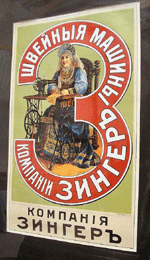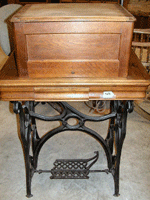When Was
-
The Sewing Machine Invented?
By Mike McLeod
Most credit Elias Howe as the inventor of the first working sewing machine in
1844. But history records many others who invented or conceptualized machines
that sewed. So how do you determine who was first?
Working sewing machine
may be the key words. Several people patented diagrams, and others created
machines that did not work, but there were sewing machines created before 1844.
As early as 1755, Charles Weisenthal was issued a patent in England for a needle
for a sewing machine, but the machine was not included in the patent
application.
Those who were issued patents for sewing machines that either
did not work or failed to materialize from the plans included: Thomas Stone and
James Henderson in 1804; Scott John Duncan also in 1804 who patented a machine
for embroidery, but there is no record of the machine; John Adams Doge and John
Knowles in America, but their machine constantly malfunctioned; Josef
Madersperger, an Austrian, who created several machines and received a patent in
1814, but who failed to get any of them to work.
Probably the first sewing
machine that actually lived up to its name was created in 1830 by Barthelemy
Thi-monnier, a French tailor. Thimonnier's machine was made entirely of wood and
used a hooked needle. It worked well enough for him to win contracts from the
French government to sew military uniforms. Thimonnier built a factory and had
80 sewing machines going when a mob of French tailors fearing for the loss of
their livelihood destroyed his factory and all his sewing machines. Undaunted,
he set up shop again just to have another mob of tailors destroy it again.
Thimonnier died a pauper in 1856.
Ironically, Walter Hunt in America built a
machine that sewed some straight stitches, but it is said he decided against
patenting it for fear of putting people out of work. Hunt was a Quaker.
In
about 1841, John Greenough is said to have built a machine that sewed by pushing
a needle completely through fabric. Yet, he was not able to generate any
interest from investors for mass producing his machine, so it went by the
wayside.
One other inventor should be remembered before entering the era of
Elias Howe and Isaac Singer. John Fisher invented a machine that created lace by
sewing, but his patent was misplaced or lost in the patent office, so he missed
out on the royalties and income that made both Howe and Singer
millionaires.
As mentioned above, most credit farmer Elias Howe with the
invention of the sewing machine. He patented it in 1845, but like those before
him, he could find no one interested in buying or marketing it. Howe turned to
England and found a backer, but their relationship was rocky, so after several
years there, he sailed home.
Here, he was surprised to find many
manufacturers making sewing machines, including Isaac Singer all of whom were
infringing on his patent. A long court battle followed, but in the end, Elias
Howe received his just reward. His annual income skyrocketed to $200,000 in one
year alone.
The sewing machine made Elias Howe a wealthy man even though
he was not the first person to invent it.
|
Both
photo, courtsey
www.artfacts.com

Russian
Singer sewing
machine
ad poster,
27 x 17
inches,
$35.

1856
Singer sewing
machine
built
on Elias
Howe patents;
housed in
a walnut
base with
a
box cover
that opens
and
flattens
to a work
surface;
$400.
|